- The Hidden Truth About Fabric Quality: 7 Expert Fabric Checking Secrets That Will Save You Money
- Why Fabric Checking at Home Matters
- The 7 Essential Fabric Checking Tests
- Test 1: Visual and Touch Assessment for Basic Fabric Checking
- Test 2: Water Absorption Test for Material Evaluation
- Test 3: Wrinkle Resistance Test for Resilience
- Test 4: The Burn Test for Precise Fiber Identification
- Test 5: The Color Fastness Test for Dye Stability
- Test 6: Shrinkage Assessment for Sizing Stability
- Test 7: Stretch Recovery Test for Shape Retention
- Transitioning from DIY Fabric Checking to Professional Quality Control
- The Economics of Smart Fabric Checking
- Building Your Personal Fabric Checking Database
- Advanced Fabric Checking Considerations
- Professional Support for Growing Brands
- The Future of Your Fabric Checking Journey
- Taking Action with Your New Knowledge
- About IGREEN TEX
- IGREEN TEX VIETNAM CO LTD
The Hidden Truth About Fabric Quality: 7 Expert Fabric Checking Secrets That Will Save You Money
Hello, I’m a production expert here at iGreen Tex Vietnam. With over a decade in the apparel export industry, I’ve handled thousands of fabric rolls. I understand the difference between quality textiles and ones that just look good at first glance. One of the biggest challenges for consumers and new brand owners is confidence in their materials. You see a fabric online or in a store. It looks perfect. But is it really what the seller claims? Will it last through multiple washes? This is where smart fabric checking comes in.
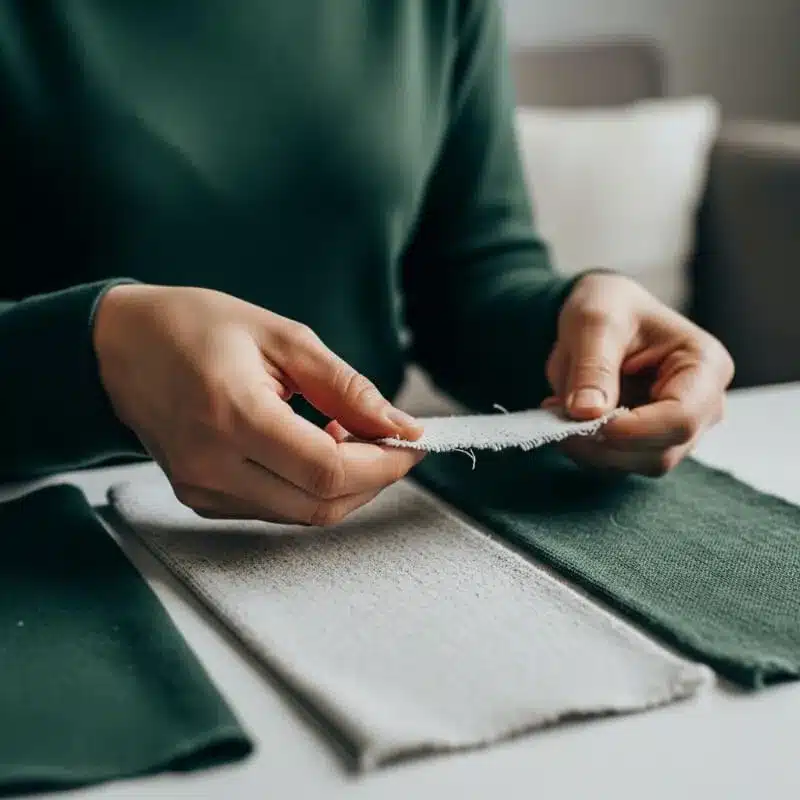
Many people believe that textile evaluation is rocket science. They think it requires expensive lab equipment and years of training. The truth is different. While professional testing is crucial for large-scale production, you can learn a lot about fabric quality with simple methods. These techniques empower you to make smarter purchasing decisions. Whether you’re a home sewer protecting your time investment, a conscious consumer avoiding fast fashion traps, or a startup founder building a quality brand, this guide is for you.
I’ll share 7 professional secrets that textile experts use daily. These aren’t just theoretical concepts. These are practical tests that work in real life. By the end of this guide, you’ll never look at fabric the same way again.
See more: Vietnam Apparel Production Scalability for Streetwear Brand
See more: Ethical Streetwear Production Vietnam
See more: Vietnam’s Textile Innovation Hubs for Streetwear Development
See more: Risk Mitigation Strategies for Manufacturing Streetwear
See more: Quality Assurance Benchmarks for Vietnamese-Made Streetwear
See more: How to Build Partnerships Vietnamese Apparel Factories
Why Fabric Checking at Home Matters
Before we dive into the tests, let’s address the elephant in the room. Why should you care about textile quality? The answer is simple: money and disappointment prevention. Poor material assessment leads to expensive mistakes.
For home sewers, inadequate evaluation means wasting hours creating a garment that shrinks to doll size after the first wash. I’ve seen talented seamstresses cry over ruined projects. For conscious consumers, this knowledge helps justify higher prices. You can verify you’re getting the premium quality you’re paying for. Too many people assume expensive equals quality. A proper inspection reveals the truth.
For small brand owners, fabric checking on supplier swatches is business survival. It helps you identify dishonest suppliers before you place large orders. One bad fabric batch can destroy your reputation and bankrupt your startup. Smart assessment prevents these disasters. Our commitment as a garment factory in Ho Chi Minh is built on this foundation of rigorous quality control.
Here’s what most people don’t know: retailers often don’t perform thorough inspections either. They might trust their suppliers blindly. This means substandard fabrics reach store shelves regularly. Your skills become your shield against these industry failures.
The 7 Essential Fabric Checking Tests
Here are seven practical tests you can perform with common household items. Each evaluation will reveal something different about the textile you’re examining. Consistent fabric checking builds good habits for quality assessment.
Test 1: Visual and Touch Assessment for Basic Fabric Checking
This is the most intuitive step in the process, but it requires focused attention. Don’t just glance at the fabric; really examine it during your initial assessment.
How to Do It: Hold the fabric up to good light. Look closely at the weave or knit structure. Is it consistent and even? Are there noticeable imperfections like slubs, snags, or thin patches? Quality fabric will have uniform structure. Run your hand over the surface. Does it feel smooth and substantial, or flimsy and rough?
What It Tells You: This test reveals basic construction quality. Inconsistencies in weave can indicate poor manufacturing. They can lead to weak spots that tear easily. Hand-feel indicates fiber quality too. High-quality fibers generally feel smoother and more pleasant. This initial fabric checking sets the stage for detailed tests.
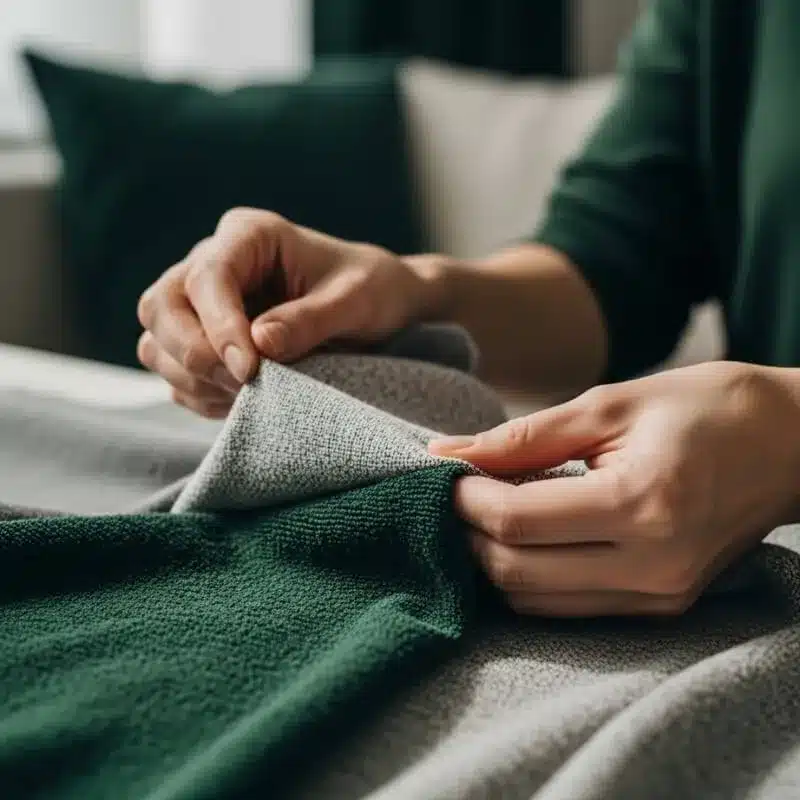
Test 2: Water Absorption Test for Material Evaluation
This simple method is excellent for gauging how fabric interacts with moisture. It can also give clues about fiber content during your inspection.
How to Do It: Place a few drops of water on the fabric surface. Observe what happens. Does water absorb quickly, spreading into fibers? Or does it bead up and take time to sink in? Quick absorption patterns vary by fiber type.
What It Tells You: Natural fibers like cotton and linen are generally very absorbent. Water sinks in fast. Synthetic fibers like polyester naturally resist moisture. Water tends to bead up on them. This quick method helps verify claims about fiber content. If fabric is sold as “100% cotton” but repels water, it might be blended. Understanding different types of common fabrics and their properties helps with accurate identification.
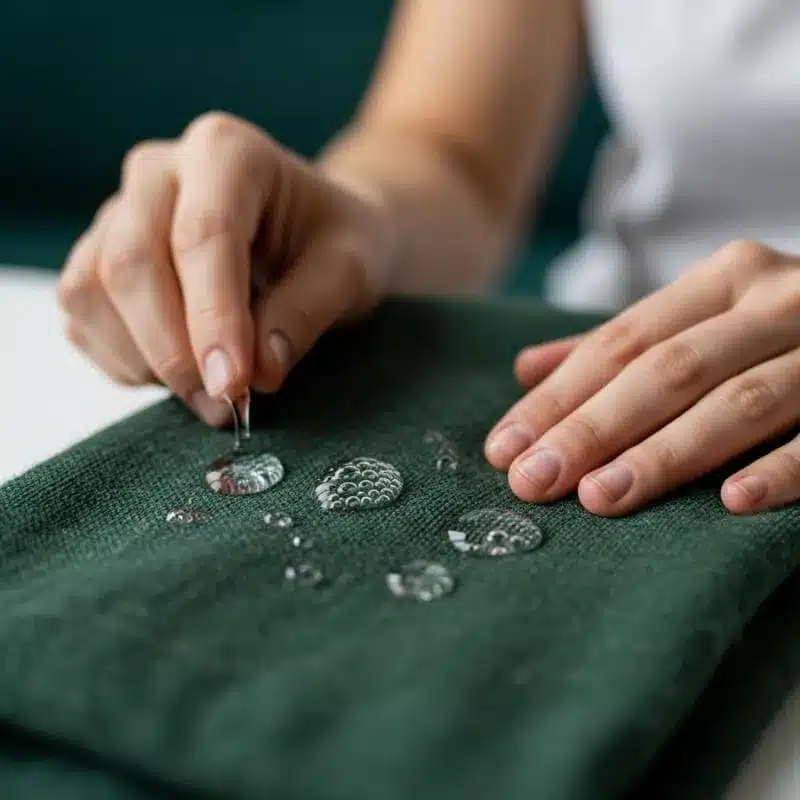
Test 3: Wrinkle Resistance Test for Resilience
Nobody likes garments that look crumpled after brief wear. This fabric checking test assesses textile resilience and wrinkle tendency.
How to Do It: Take a small fabric section and clench it tightly in your fist for 30 seconds. Release it and lay flat. Observe the results. Does it spring back to a smooth state? Or is it covered in deep, stubborn creases?
What It Tells You: Fabrics with good resilience resist wrinkling well during this assessment. Natural fibers like cotton and linen wrinkle easily; this is normal. This test helps manage expectations. For travel clothes, you want fabric that passes this evaluation excellently. It also helps identify blends. Cotton-polyester blends wrinkle much less than pure cotton.
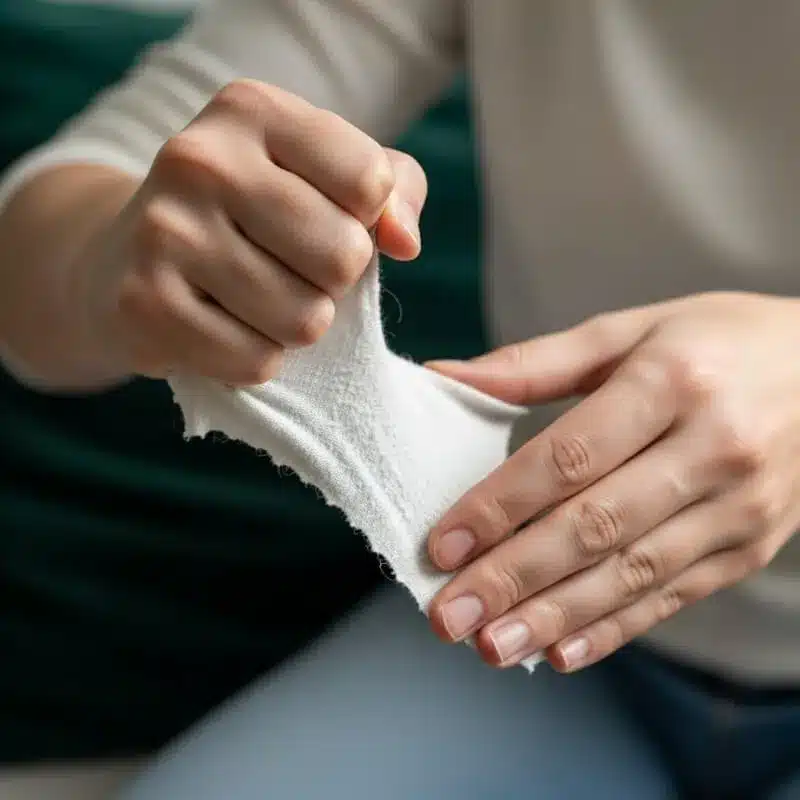
Test 4: The Burn Test for Precise Fiber Identification
This is the most definitive at-home test for identifying fiber content. It must be done with extreme caution. Always perform this fabric checking test in well-ventilated areas, over fireproof surfaces, with water nearby.
How to Do It: Carefully cut a tiny fabric swatch. Using long tweezers, bring it close to a flame edge. Observe how it reacts to heat. Note the flame color as it burns. Notice the smoke smell. Examine the ash or residue after cooling.
What It Tells You: This evaluation works like textile forensics.
- Cotton/Linen: Burns quickly with a yellow flame. Smells like burning paper. Leaves fine, soft grey ash.
- Wool/Silk: Sizzles and curls from the flame. Often self-extinguishing. Smells like burning hair. Leaves brittle, black ash.
- Polyester/Nylon: Melts and shrinks from the flame. Burns with a chemical smell. Leaves a hard, black bead.
This method uncovers the truth if you suspect mislabeled fabric. It’s an advanced but powerful fabric checking technique.
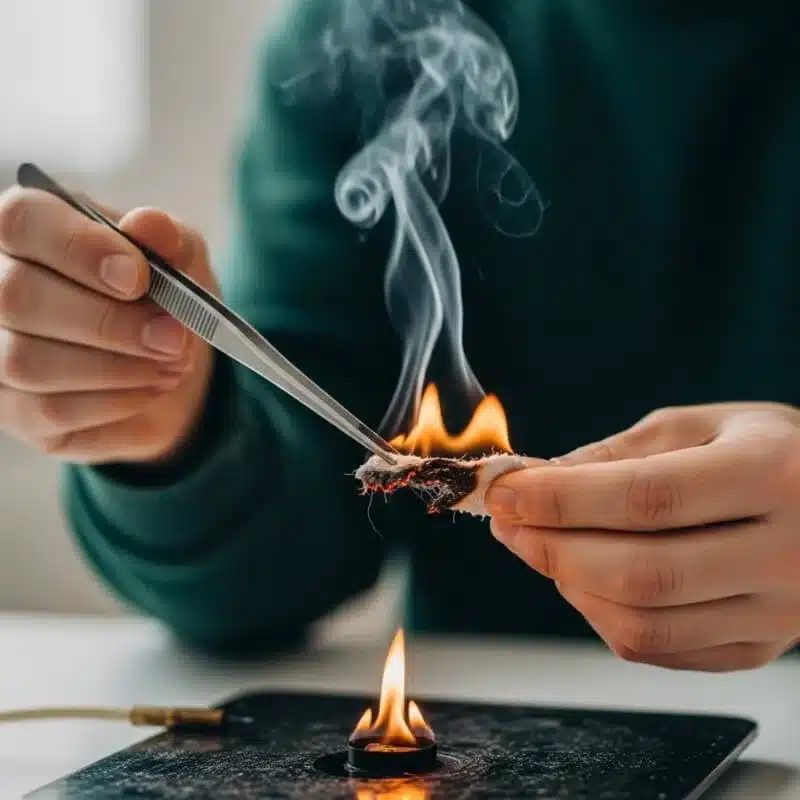
Test 5: The Color Fastness Test for Dye Stability
This fabric checking test prevents the heartbreak of new garments bleeding color onto other clothes during washing.
How to Do It: Take a small fabric swatch. Wet a piece of white cotton cloth. Place the wet white cloth on your colored fabric and iron with a hot iron until dry. Alternatively, rub the wet white cloth vigorously against the colored fabric surface.
What It Tells You: After the test, examine the white cloth. Is there color transfer? If the white cloth shows staining, the dye is not fast. The garment will likely bleed during washing. This step is crucial for brightly colored or dark fabrics. Quality textiles should show minimal color transfer during a proper evaluation.
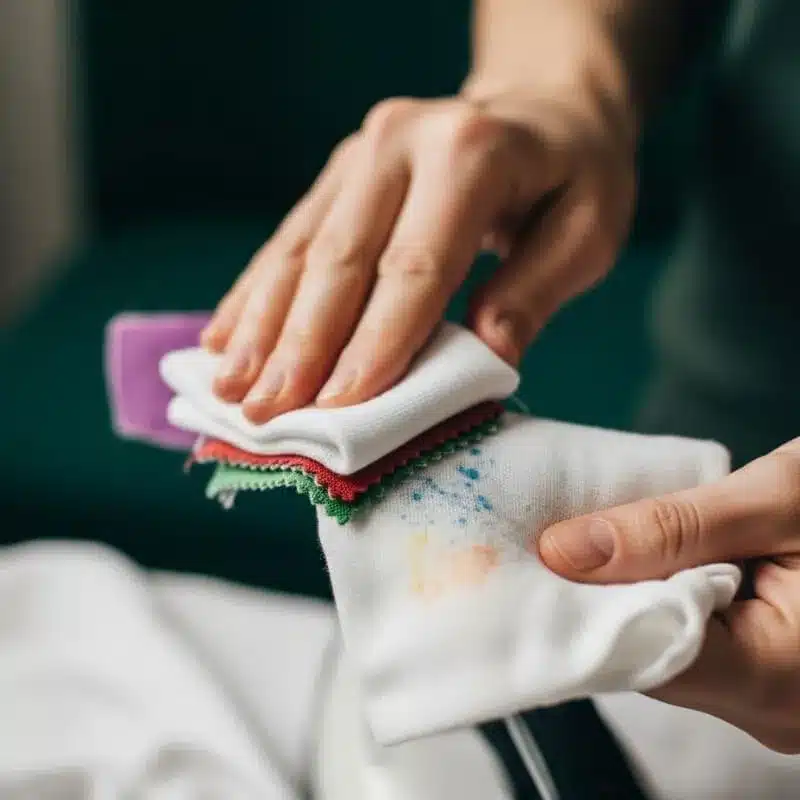
Test 6: Shrinkage Assessment for Sizing Stability
This is perhaps the most important fabric checking test for anyone who sews. It determines how much a fabric will shrink after washing and drying.
How to Do It: Cut a precise square from the fabric, like 10cm by 10cm. Mark the edges clearly with a permanent marker. Wash and dry this swatch exactly as you intend to care for the final garment. Once completely dry, measure it again carefully.
What It Tells You: Calculate the shrinkage percentage from this test. If your 10cm square becomes 9.5cm, it shrank 5%. This means you MUST pre-wash the entire fabric yardage before cutting patterns. Otherwise, finished garments will be too small after the first wash. This essential step ensures an accurate final fit. For brands, understanding shrinkage impacts how apparel manufacturing costs are calculated because it affects material requirements and sizing accuracy.
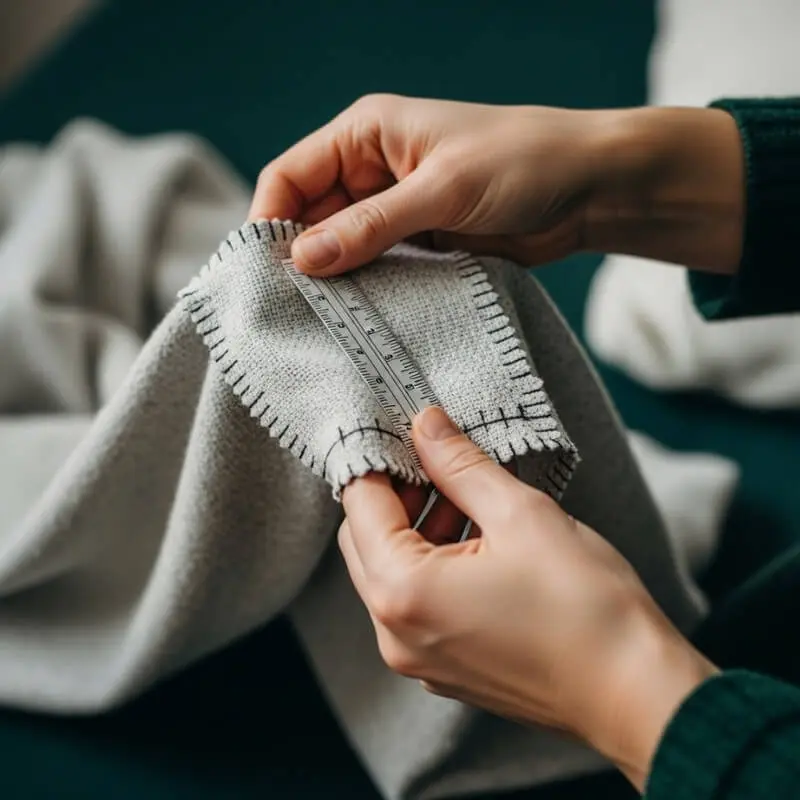
Test 7: Stretch Recovery Test for Shape Retention
For any fabric with stretch, this fabric checking test is vital. It assesses not just the stretch amount, but how well it returns to its original shape.
How to Do It: Take a fabric section and gently stretch it along its width. Hold for 10 seconds. Then release. Observe how quickly and completely it returns to its original size. Does it snap back immediately? Or does it remain slightly stretched and saggy?
What It Tells You: This test measures recovery. Poor recovery means garments lose shape over time. Think of baggy knees in leggings or stretched necklines in t-shirts. High-quality stretch fabrics have excellent recovery during this evaluation. This test helps predict long-term garment shape and fit. Good fabric checking never skips this for knit materials.
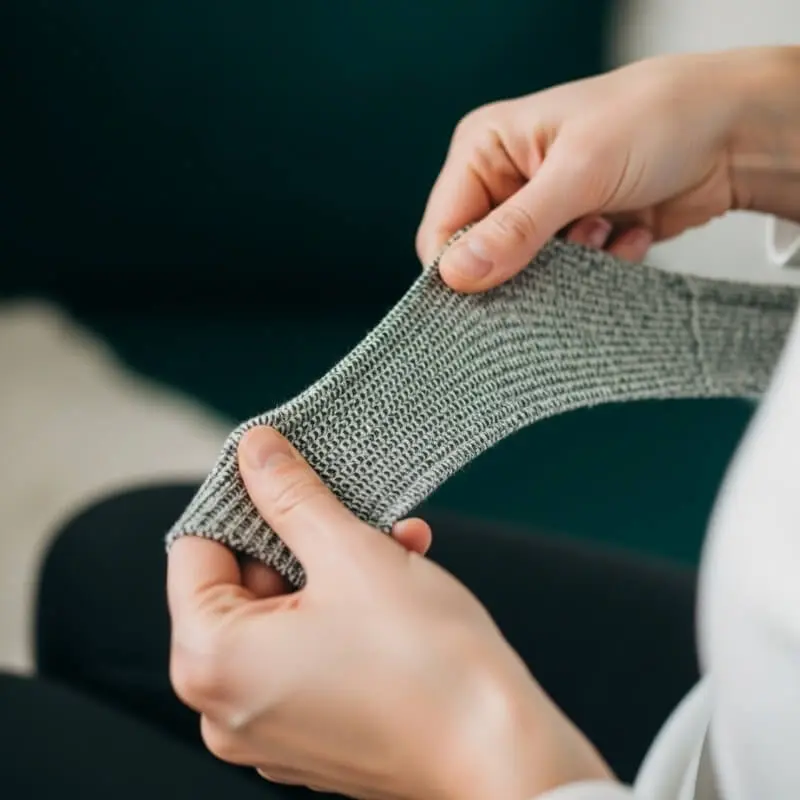
Transitioning from DIY Fabric Checking to Professional Quality Control
These seven tests provide an excellent foundation for personal assessment. They empower you to become a more discerning consumer and smarter creator. Through systematic evaluation, you can identify basic fiber types, assess construction quality, and predict fabric behavior patterns.
However, when your fashion brand grows beyond small batches, the requirements change dramatically. While these tests work perfectly for vetting supplier samples, they become impractical for inspecting thousands of yards. This transition point requires professional manufacturing partners with established systems for fabric checking.
Growing brands need partners who understand that effective material evaluation goes beyond simple tests. Professional fabric checking involves documented procedures, calibrated testing equipment, and systematic quality control protocols. This is where the process of finding the best clothing manufacturers becomes crucial for scaling your business successfully.
Professional manufacturers employ standardized methods like the 4-point inspection system. This method assigns penalty points based on defect severity and frequency. Fabrics exceeding acceptable point thresholds get rejected before production begins. This systematic approach prevents quality issues from reaching finished garments.
Advanced assessment also includes laboratory testing for properties like tensile strength, abrasion resistance, and chemical composition. Professional equipment measures these characteristics precisely. This data-driven material inspection ensures materials meet specific performance requirements for different product categories.
The Economics of Smart Fabric Checking
Understanding material quality saves money at every level. For individual consumers, these skills prevent costly purchase mistakes. You’ll avoid fabrics that shrink, fade, or fall apart quickly. This knowledge helps you buy less frequently but choose better quality.
For emerging brands, early-stage fabric checking prevents expensive production disasters. One failed fabric batch can cost thousands in wasted materials and labor. Proper evaluation catches problems while you can still change suppliers or adjust specifications.
The relationship between textile assessment and production costs is complex. Higher-quality fabrics cost more initially but often reduce manufacturing problems. They cause fewer machine stoppages, create less waste, and require fewer quality repairs. This efficiency impacts overall production economics significantly.
Building Your Personal Fabric Checking Database
Effective evaluation improves with experience and record-keeping. Start documenting your results systematically. Create a simple spreadsheet tracking fabric types, suppliers, test results, and long-term performance observations.
Note how different fabrics behave during your tests. Record which suppliers consistently provide materials that pass your standards. Track seasonal variations in quality – some suppliers struggle with consistency during peak production periods.
This personal database becomes invaluable as you develop expertise. You’ll start recognizing patterns and predicting problems before they occur. Your skills will evolve from basic quality assessment to sophisticated material evaluation.
Pay attention to how your test results correlate with real-world performance. Does a fabric that barely passes your shrinkage test actually shrink more than expected? Does excellent stretch recovery translate to good garment fit over time? These observations refine your accuracy.
Advanced Fabric Checking Considerations
As your skills develop, you’ll notice subtleties that beginners miss. Seasonal humidity affects how fabrics behave during testing. Room temperature influences burn test results. Lighting conditions impact visual inspection accuracy.
Professional material inspection accounts for these variables through controlled testing environments. However, understanding these factors improves your home evaluation reliability. Always perform tests under similar conditions for consistent results.
Consider the intended use when interpreting the results. A fabric that fails wrinkle resistance might be perfect for structured garments that get pressed regularly. Materials with poor stretch recovery could work well for loose-fitting designs where shape retention matters less.
Your fabric checking goals should align with your projects’ requirements. Athletic wear needs different properties than formal wear. Understanding these relationships makes your evaluation more purposeful and effective.
Professional Support for Growing Brands
At iGreen Tex, we understand the transition from individual assessment to professional production requirements. We’ve helped hundreds of brands navigate this challenging phase. Our protocols for fabric checking protect your brand reputation while ensuring cost-effective production.
We perform comprehensive material inspection on all incoming materials before production begins. Our quality control team uses both traditional inspection methods and modern testing equipment. This multi-layered approach catches problems that single-method testing might miss.
Our fabric checking reports provide detailed documentation for your records. You’ll know exactly what tests were performed, what the results showed, and how your materials compare to industry standards. This transparency builds confidence in your supply chain quality.
We also offer consultation services for brands developing their own quality standards. Our experts can help you establish appropriate testing protocols for your specific product categories. This guidance ensures your requirements for fabric checking align with market expectations and production capabilities.
The Future of Your Fabric Checking Journey
Mastering these seven tests is just the beginning of your quality education. As you gain experience, you’ll develop an intuition about fabric quality that goes beyond mechanical testing. You’ll learn to spot problems with a quick visual assessment and feel quality differences immediately.
This expertise becomes a competitive advantage whether you’re shopping for personal projects or building a fashion business. Suppliers respect customers who demonstrate quality knowledge. They’re more likely to offer their best materials and honest advice when they know you understand fabric checking principles.
Your skills will continue evolving as textile technology advances. New fiber types and fabric treatments require updated testing approaches. Stay curious and keep learning about materials science developments that affect material evaluation methods.
Remember that effective fabric checking is both science and art. The technical knowledge provides objective assessment tools, but experience develops the subjective judgment that separates good fabric checkers from great ones.
Taking Action with Your New Knowledge
Now that you understand these professional secrets, start practicing immediately. Don’t wait for the perfect fabric sample or ideal testing conditions. Begin with fabrics you already own. Practice these fabric checking techniques until they become second nature.
Start simple with visual inspection and water testing. Master these basic methods before moving to more complex tests like burn testing. Build confidence gradually as your skills in fabric checking develop.
Share your knowledge with friends and fellow creators. Teaching others reinforces your own learning and helps build a community of quality-conscious consumers. The more people who understand fabric checking, the better the overall market becomes.
Document your journey through photos and notes. This record will become valuable reference material as you encounter similar fabrics in the future. Your personal database of fabric checking will grow into a powerful decision-making tool.
We encourage you to use these techniques as stepping stones toward greater quality awareness. When you’re ready to scale your operations beyond personal fabric checking capabilities, remember that professional partners like iGreen Tex are here to support your growth with industrial-grade quality control systems.
About IGREEN TEX
IGREEN TEX is a provider of fashion and textile products, offering a wide range of both domestically and internationally. Our commitment to quality ensures that our products not only meet the highest standards but also promote eco-friendly practices, in Vietnam sportswear manufacturing.
If you want to read more information about canvas bags, and if you want to tote bags at Ho Chi Minh City, you can see it here!!!
To view product information click here
Visit our website to learn more about our products and services: IGREEN TEX
IGREEN TEX VIETNAM CO LTD
Address: No. 6 – 6A, D52 Street, Ward Bay Hien, HCMC
E-mail: info@igreentex.com
WhatsApp/Viber/Zalo: +84 938.045.900